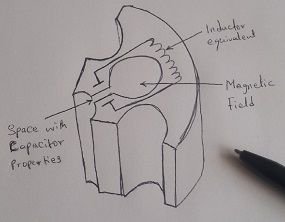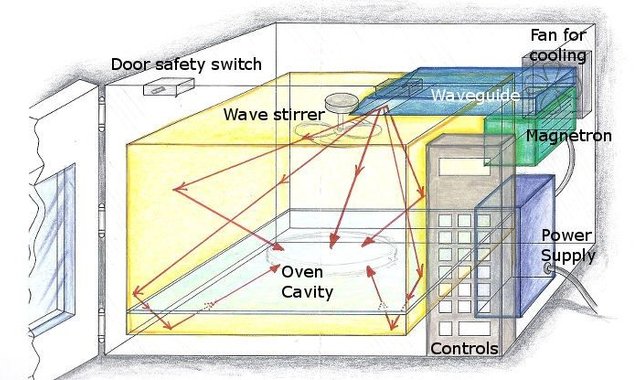Microwave Ovens: Turning waves into weapons
Initially, cooking involves heating our utensils directly with fire or its equivalent but the story changed with the invention of microwave oven. It always comes as plug-and-play because even an unexposed persons can be taught or can even figure out how to use the oven, basically it’s just twist of a knob and pressing a button the cooking is done in minutes. The predominant characteristic of microwave oven is that heating is done volumetrically which means that the target material absorbs microwave energy from a source and convert this energy internally to heat, this is different from the conventional method of heating described above.

credit: AO
What then is microwave….
Microwaves are actually electromagnetic in nature just like light waves and maintains wavelengths between 1 millimeter to 1 meter as shown in the electromagnetic spectrum below. By default microwaves are employed widely in telecommunication as it can transport telephone signals to a very long distance. It is also used widely in speed detectors, satellite communication whereby signals are transmitted to satellite and the satellite transmits the signal back to any desired location on earth.

credit: HCLTECH
Waves are sinusoidal in nature, that is they change polarity for each cycle of the wave. This change in cycle for microwave happens up to millions of times per second because their wave length (the successive distance between crests) are very small. The molecules of water present in our foods also have charges, the positive and the negative ends, hence when microwave bombard these food molecules, they cause the polarities of these molecules to vibrate or rotate at the same incident frequency, that is, millions of periods per second. These vibration of the food molecules create molecular friction, hence causing the food to literally heat itself up without heating up the plates or glass used in placing them in the oven because the microwaves do not interact on the molecular level with these equipment or utensils.
How microwave works
The working principle of microwave is a very simple one and can be summarized below:
The Magnetron
The main component of the microwave oven is the magnetron and the input high voltage. The most widely used magnetron type is the cavity magnetrons. The cavity available in the magnetron can be between 8 cavities to 20 cavities. The cavity is the anode (positively charged electric conductor) which is usually in the form of hollow blocks. The cathode is in the form of a rotating structure held in place by a strong filament lead in the middle of the hollow anodes as shown below.

credit: radar tutorial
The cathode which is made up of high-emission materials are heated up indirectly by the filament. As shown in the hand sketch image on the right (equivalent circuit for the anode cavity) , a narrow slot which acts as a capacitor runs into each of these hollow anode structures opening up at the center of the tube thereby splitting the central portion of the tube into many segments with respect to available cavity.
))
credit: @henrychidiebere
The self-excitation happens by the electric field emerging from the positive plate of the capacitive equivalent plates shown above and then gets enclosed to the negative plate. Magnetic field also gets enclosed by moving from the cathode to the anode.
The basic operation of the magnetron is in four phases. Phase 1 involves the production and the acceleration of beam of electron in a direct current field. These electron are generated by heating the cathode in the absence of magnetic field. The movement of the generated electron can be controlled by varying the strength of the magnetic field. The Phase 2 involves modulating the velocity of the beam of electrons. As stated earlier, the generated electrons moves with high speed to the various cavities, which is the cathode. The anodes which are more positively charged attracts electrons faster while the anodes which are more negatively charged attracts electron slowly. By varying the charge at the anode, the speed of the electron can be modulated.
The third phase involves forming electron “bunches” by the modulated velocity of the electron this in turn results in density modulation because of the action of the electrons moving back to the cathode while some of the electrons are moving towards the anode producing a pattern that looks like spokes of moving wheel as shown in the figure to the left.Finally, the phase 4 involves the dispensing of these generated energy to the ac field. Energy is taken up when electron moves against the electric field. This energy helps accelerated the electrons. In the same manner, energy is sent back to the electric field when the electron slows down as it reaches the anode. By these movements, the electron helps sustain these up and down movement by taking up energy from the direct current field and handing it over to the alternating current field.
The power supply
The power supply the microwave oven is made up of two major components; the phase control circuit and the synchronous switch. These switches opens the current flow path to the microwave electrical components, especially the transformer unless it is actuated which then closes this path. An “on and off” switch are connected in series alongside interlocks with the power supply line. A phase control circuit keeps the operation of the power circuit on hold until cooking has commenced.

credit: ElProCus
This phase control circuit chooses the appropriate phase of the line voltage that is suitable for the initialization of the synchronous switch. By this operation, the phase control circuit is then in tune with transformers’ characteristics and hence be able to sense the amount of the applied line voltage so that the first conduction offered by the synchronous switch operates within a range capable of reducing transient voltage spike during operation.
The cavity
The cavity of the microwave oven reflects the overall operating principle of the oven which is interaction of the high frequency electromagnetic wave with food molecules. When this high frequency waves are generated, they are propagated to the chamber of the oven which is a multimode resonant cavity which helps reflects waves from the walls in order to create a standing wave pattern. The design of the cavity is aimed at maintaining uniform density within the oven space for uniform heating effect and also ensure the cavity presents the required subject (the food) to the magnetron.

The microwave applicator is the major part of the cavity since the microwave finds their way to the target material through the applicator. The temperature within the material under heating is determined by the distributions of the fields inside the applicator. Typical applicators includes but not limited to single mode cavities, waveguides, multi-mode applicators, etc. The resonant cavities are predominantly used in the industry because of their high field strengths.
Conclusion
The microwave oven is said to approach heating "from inside out" because the interaction of an incident high frequency microwave on the water molecules present in foods creates vibrations at that molecular level cable of creating friction enough to heat up food from inside out. The major component of the microwave is the microwave generator which is done by the magnetron circuit, the high voltage power supply, the cavity and the control circuits. Foods completely void of water cannot be heated using the microwave because of the explanation i gave above. The best material for placing foods in the microwave cavity is the porcelain or the stoneware. Shinny and reflective utensils might leave the food uncooked since they can easily bounce back the generated wave causing no heating effect.
References
- Magnetron -radartutorial
- microwave oven transformer power supply -deanostoy
- microwave oven -wikipedia
- design consideration for microwave oven cavities -researchgete

Being A SteemStem Member
This is a very detailed in-depth article ,it caught my eye because daughter is doing wave -energy at school,Thanks for sharing .
Thank you for the comprehensive and very instructive text. I think this will help many people realize that a microwave oven is not harmful for health. Also, the text, great sheme and photos can help us to fix ours microwave alone :D